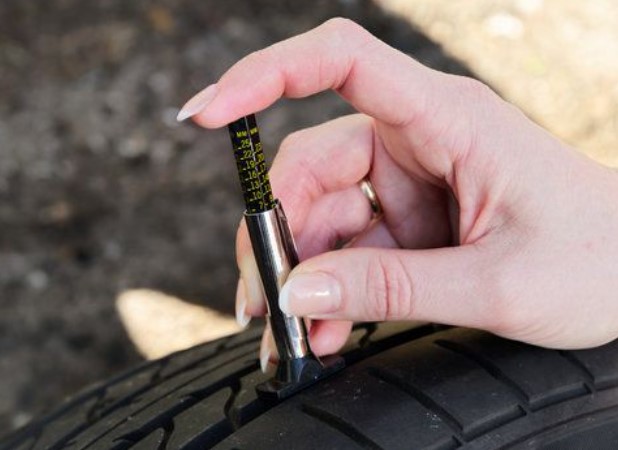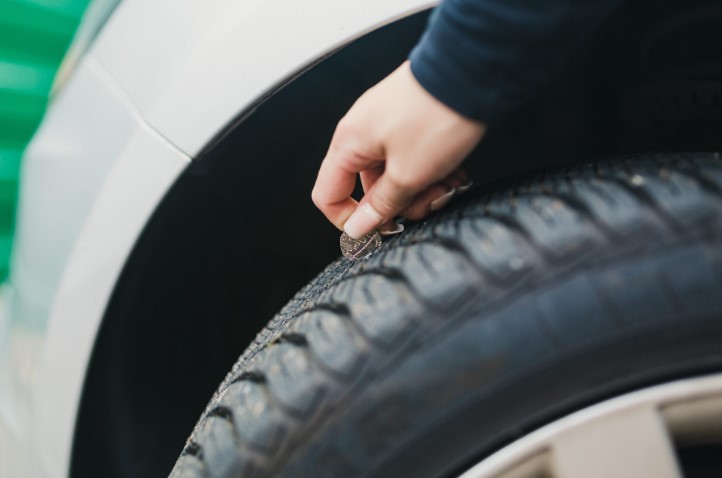Tyre tread is the grooved outer layer of a tyre that provides traction, grip, and water drainage. Ensuring your tyres have adequate tread depth is crucial for your safety and the performance of your vehicle. In the UK, there are specific legal requirements for minimum tread depth, and failing to comply can result in fines and penalties.
This guide will walk you through the different methods of measuring tyre tread in the UK, including the use of a tread depth gauge, the penny test, and inspecting tread wear indicators. We’ll also provide valuable tips on maintaining your tyres and ensuring they are always in optimal condition.
Importance of Regularly Measuring Tyre Tread
Safety Concerns
As your tyres wear down, the depth of the tread decreases, reducing your vehicle’s ability to grip the road. This becomes especially dangerous in wet conditions, where water cannot be channelled away efficiently, leading to aquaplaning. Aquaplaning occurs when your tyres lose contact with the road surface due to water buildup, severely impacting your ability to steer and brake. Worn tyres also lengthen stopping distances, increasing the chances of collisions.
Legal Implications in the UK
Driving with insufficient tyre tread is illegal in the UK. If caught with tyres below the minimum legal tread depth of 1.6mm, you could face a fine of up to £2,500 per tyre and three penalty points on your licence. These penalties make it crucial for drivers to regularly monitor their tyre tread to avoid legal repercussions.
Impact on Performance and Fuel Efficiency
In addition to safety, tyres with proper tread depth contribute to optimal vehicle performance and fuel efficiency. Tyres with worn tread not only reduce grip but also increase rolling resistance, causing the engine to work harder and consume more fuel. By keeping your tyres in good condition, you can improve your car’s overall performance and save money on fuel in the long run.
Tools Required for Measuring Tyre Tread
There are several methods and tools you can use to measure tyre tread depth. Here are the most common:
Tyre Tread Depth Gauge
A tyre tread depth gauge is a simple and accurate tool for measuring tread depth. It is widely available at car accessory stores or online retailers. A depth gauge is easy to use and provides precise measurements of tread depth across various parts of the tyre, helping you identify uneven wear or dangerously low tread levels.
20p Coin Test
The 20p coin test is a quick and easy way to check if your tyres are above the legal tread limit. This method is particularly popular in the UK because it doesn’t require any special equipment. You can perform this test in just a few seconds, and while it may not provide an exact measurement, it offers a reliable indication of whether your tyres meet the legal requirements.
Visual Inspection
A visual inspection of your tyres can also reveal important information about their condition. Look for signs of wear such as cracks, bulges, or areas where the tread is noticeably worn down. Uneven wear, where one part of the tyre is more worn than the rest, could indicate alignment or suspension issues that need addressing.
Step-by-Step Guide to Measuring Tyre Tread
Step 1: Locate the Tread Wear Indicators
Modern tyres are equipped with tread wear indicators—small raised bars located in the grooves of the tyre. These bars are typically set at the legal limit of 1.6mm. If the tread is level with these indicators, it’s time to replace your tyres.

Image source: doityourself.com
Step 2: Use a Depth Gauge
For a precise measurement, use a tyre tread depth gauge. Follow these steps:
- Insert the Gauge: Place the gauge into the grooves of the tread.
- Take Readings: Take measurements at several points around the tyre, particularly across the central three-quarters of the tread. Be sure to check for uneven wear.
- Compare Results: Ensure that all readings are above the legal limit of 1.6mm.
If your measurements are below this threshold, your tyres must be replaced immediately.

Image source: cambridgecentrehonda.com
Step 3: Perform the 20p Coin Test
This method is a popular way of checking tyre tread depth in the UK:
- Insert the 20p Coin: Place a 20p coin into the main tread grooves of the tyre.
- Check the Outer Band: If the outer band of the coin is visible, your tread depth is likely below the legal minimum of 1.6mm, and you should replace your tyres.
Repeat this process at several points around each tyre to ensure a consistent reading.

Image source: blackcircles.com
Step 4: Inspect for Uneven Wear
In addition to measuring the depth, visually inspect the tyre for signs of uneven wear. Uneven tread wear could suggest problems with your vehicle’s alignment, suspension, or tyre pressure. Addressing these issues early can prevent further damage to your tyres and prolong their lifespan.

Image source: dubizzle.com
When to Replace Your Tyres
Understanding the Results
If your tyres have less than 1.6mm of tread depth, they are legally unsafe, and you must replace them immediately. However, many tyre safety experts recommend replacing tyres once the tread depth falls below 3mm, as tyres with more tread provide better grip, especially in wet conditions.
Manufacturer Recommendations
Most vehicle manufacturers suggest replacing tyres every 20,000-30,000 miles, depending on your driving habits and the conditions in which you drive. Even if your tyres still have tread above the legal limit, it’s important to consider other factors like age, visible wear, and overall condition when determining whether to replace them.
Other Signs Your Tyres Need Replacing
Even if your tread depth is within the legal limit, other signs might indicate the need for tyre replacement. These include:
- Cracks or Cuts: Visible cracks or cuts in the sidewall may indicate structural damage.
- Bulges or Blisters: Bulging areas could be a sign of internal damage and should be addressed immediately.
- Vibrations: Excessive vibrations while driving could signal uneven wear or alignment issues.
Professional Tyre Checks
Benefits of Getting a Professional Tyre Check
While DIY checks are useful, having your tyres professionally inspected provides a more thorough assessment. Tyre specialists can evaluate not only tread depth but also tyre pressure, alignment, and overall condition. Regular professional checks help ensure your tyres remain safe and legal.
Tyre Replacement Services in the UK
When it’s time to replace your tyres, it’s important to choose a reputable service. Many UK garages and tyre centres offer tyre fitting and alignment services. Some well-known UK tyre service providers include Kwik Fit, National Tyres, and ATS Euromaster. These companies offer comprehensive tyre services, from fitting new tyres to ensuring proper alignment and balance.
Conclusion
Regularly checking your tyre tread depth is essential for maintaining vehicle safety, performance, and compliance with UK law. With methods like the 20p coin test and a tread depth gauge, you can easily monitor the condition of your tyres.
Remember, worn tyres reduce traction, increase stopping distances, and put you at greater risk of accidents. If your tread depth is below 1.6mm, replace your tyres immediately to avoid legal penalties and ensure your safety on the road.
Frequently Asked Questions (FAQs)
You can measure tyre tread using a tread depth gauge or by performing the 20p coin test. Insert the gauge into the tyre grooves to get an exact depth reading. For the 20p test, place a 20p coin in the tread groove—if the outer band of the coin is visible, your tread is below the legal limit.
Tyre tread is measured in millimetres. You can use a tread depth gauge or a simple 20p coin test to check the depth. Measurements should be taken across different points of the tyre, especially in the central three-quarters of the tread.
A tyre tread wear indicator is a small raised bar located in the grooves of your tyres. These bars indicate the minimum legal tread depth (1.6mm). If the tread is level with the indicator, it’s time to replace your tyres.
The legal minimum tyre tread depth in the UK is 1.6mm across the central three-quarters of the tyre and around the entire circumference. Driving with less than this tread depth is illegal and can result in fines and penalty points.
